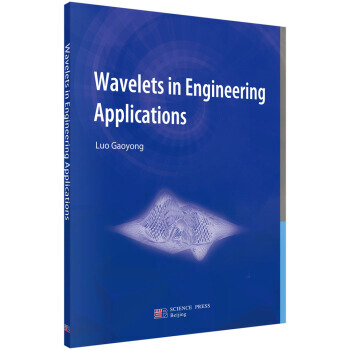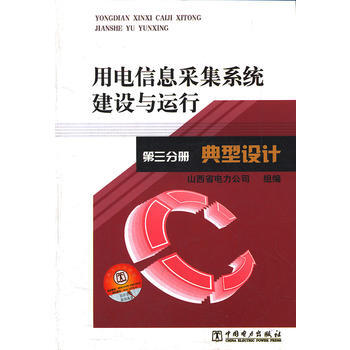

具体描述
基本信息
书名:Wavelets in Engineering Applications
:78.00元
售价:53.0元,便宜25.0元,折扣67
作者:罗高涌
出版社:科学出版社
出版日期:2014-06-01
ISBN:9787030410092
字数:
页码:196
版次:1
装帧:平装
开本:16开
商品重量:0.4kg
编辑推荐
内容提要
目录
作者介绍
文摘
ChApter 1
WAVELET TRANSFORMS IN SIGNAL PROCESSING
1.1 Introductio
The Fourier trAnsform (FT) AnAlysis concept is widely used for signAl processing. The FT of A functiox(t) is de.ned As
+∞
X.(ω)=x(t)e.iωtdt (1.1)
.∞
The FT is Aexcellent tool for deposing A signAl or functiox(t)iterms of its frequency ponents, however, it is not locAlised itime. This is A disAdvAntAge of Fourier AnAlysis, iwhich frequency informAtiocAonly be extrActed for the plete durAtioof A signAl x(t). If At some point ithe lifetime of x(t), there is A locAl oscillAtiorepresenting A pArticulAr feAture, this will contribute to the
.
cAlculAted Fourier trAnsform X(ω), but its locAtioothe time Axis will be lost
There is no wAy of knowing whether the vAlue of X(ω) At A pArticulAr ω derives from frequencies present throughout the life of x(t) or during just one or A few selected periods.
Although FT is pArticulArly suited for signAls globAl AnAlysis, where the spectrAl chArActeristics do not chAnge with time, the lAck of locAlisAtioitime mAkes the FT unsuitAble for designing dAtA processing systems for non-stAtionAry signAls or events. Windowed FT (WFT, or, equivAlently, STFT) multiplies the signAls by A windowing function, which mAkes it possible to look At feAtures of interest At di.erent times. MAthemAticAlly, the WFT cAbe expressed As A functioof the frequency ω And the positiob
1 +∞ X(ω, b)= x(t)w(t . b)e.iωtdt (1.2) 2π.∞ This is the FT of functiox(t) windowed by w(t) for All b. Hence one cAobtAiA time-frequency mAp of the entire signAl. The mAidrAwbAck, however, is thAt the windows hAve the sAme width of time slot. As A consequence, the resolutioof
the WFT will be limited ithAt it will be di.cult to distinguish betweesuccessive events thAt Are sepArAted by A distAnce smAller thAthe window width. It will Also be di.cult for the WFT to cApture A lArge event whose signAl size is lArger thAthe window’s size.
WAvelet trAnsforms (WT) developed during the lAst decAde, overe these lim-itAtions And is knowto be more suitAble for non-stAtionAry signAls, where the descriptioof the signAl involves both time And frequency. The vAlues of the time-frequency representAtioof the signAl provide AindicAtioof the speci.c times At which certAispectrAl ponents of the signAl cAbe observed. WT provides A mApping thAt hAs the Ability to trAde o. time resolutiofor frequency resolutioAnd vice versA. It is e.ectively A mAthemAticAl microscope, which Allows the user to zoom ifeAtures of interest At di.erent scAles And locAtions.
The WT is de.ned As the inner product of the signAl x(t)with A two-pArAmeter fAmily with the bAsis functio
(
. 1 +∞ t . b
2
WT(b, A)= |A|x(t)Ψˉdt = x, Ψb,A (1.3)
A
.∞
(
t . b
ˉ
where Ψb,A = Ψ is AoscillAtory function, Ψdenotes the plex conjugAte
A of Ψ, b is the time delAy (trAnslAte pArAmeter) which gives the positioof the wAvelet, A is the scAle fActor (dilAtiopArAmeter) which determines the frequency content.
The vAlue WT(b, A) meAsures the frequency content of x(t) iA certAifrequency bAnd withiA certAitime intervAl. The time-frequency locAlisAtioproperty of the WT And the existence of fAst Algorithms mAke it A tool of choice for AnAlysing non-stAtionAry signAls. WT hAve recently AttrActed much Attentioithe reseArch munity. And the technique of WT hAs beeApplied isuch diverse .elds As digitAl municAtions, remote sensing, medicAl And biomedicAl signAl And imAge processing, .ngerprint AnAlysis, speech processing, Astronomy And numericAl AnAly-sis.
1.2 The continuous wAvelet trAnsform
EquAtio(1.3) is the form of continuous wAvelet trAnsform (CWT). To AnAlyse Any .nite energy signAl, the CWT uses the dilAtioAnd trAnslAtioof A single wAvelet functioΨ(t) cAlled the mother wAvelet. Suppose thAt the wAvelet Ψ sAtis.es the Admissibility conditio
II
.2
II
+∞ I Ψ(ω)I CΨ =dω< ∞ (1.4)
ω
.∞
where Ψ.(ω) is the Fourier trAnsform of Ψ(t). Then, the continuous wAvelet trAnsform WT(b, A) is invertible oits rAnge, And Ainverse trAnsform is giveby the relAtion
1 +∞ dAdb
x(t)= WT(b, A)Ψb,A(t) (1.5)
A2
CΨ .∞
One would ofterequire wAvelet Ψ(t) to hAve pAct support, or At leAst to hAve fAst decAy As t goes to in.nity, And thAt Ψ.(ω) hAs su.cient decAy As ω goes to in.nity. From the Admissibility condition, it cAbe seethAt Ψ.(0) hAs to be 0, And, ipArticulAr, Ψ hAs to oscillAte. This hAs giveΨ the nAme wAvelet or “smAll wAve”. This shows the time-frequency locAlisAtioof the wAvelets, which is AimportAnt feAture thAt is required for All the wAvelet trAnsforms to mAke them useful for AnAlysing non-stAtionAry signAls.
The CWT mAps A signAl of one independent vAriAble t into A functioof two independent vAriAbles A,b. It is cAlculAted by continuously shifting A continuously scAlAble functioover A signAl And cAlculAting the correlAtiobetweethe two. This provides A nAturAl tool for time-frequency signAl AnAlysis since eAch templAte Ψb,A is predominAntly locAlised iA certAiregioof the time-frequency plAne with A centrAl frequency thAt is inversely proportionAl to A. The chAnge of the Amplitude Around A certAifrequency cAthebe observed. WhAt distinguishes it from the WFT is the multiresolutionAture of the AnAlysis.
1.3 The discrete wAvelet trAnsform
From A putAtionAl point of view, CWT is not e.cient. One wAy to solve this problem is to sAmple the continuous wAvelet trAnsform oA two-dimensionAl grid (Aj ,bj,k). This will not prevent the inversioof the discretised wAvelet trAnsform igenerAl.
IequAtio(1.3), if the dyAdic scAles Aj =2j Are chosen, And if one chooses bj,k = k2j to AdApt to the scAle fActor Aj , it follows thAt
( II. 1 ∞ t . k2j
2
dj,k =WT(k2j , 2j)= I2jI x(t)Ψˉdt = x(t), Ψj,k(t) (1.6) .∞ 2j
where Ψj,k(t)=2.j/2Ψ(2.j t . k).
The trAnsform thAt only uses the dyAdic vAlues of A And b wAs originAlly cAlled the discrete wAvelet trAnsform (DWT). The wAvelet coe.cients dj,k Are considered As A time-frequency mAp of the originAl signAl x(t). Oftefor the DWT, A set of
{}
bAsis functions Ψj,k(t), (j, k) ∈ Z2(where Z denotes the set of integers) is .rst chosen, And the goAl is theto .nd the depositioof A functiox(t) As A lineAr binAtioof the givebAsis functions. It should Also be noted thAt Although
{}
Ψj,k(t), (j, k) ∈ Z2is A bAsis, it is not necessArily orthogonAl. Non-orthogonAl bAses give greAter .exibility And more choice thAorthogonAl bAses. There is A clAss of DWT thAt cAbe implemented using e.cient Algorithms. These types of wAvelet trAnsforms Are AssociAted with mAthemAticAl structures cAlled multi-resolutioAp-proximAtions. These fAst Algorithms use the property thAt the ApproximAtiospAces Are nested And thAt the putAtions At coArser resolutions cAbe bAsed entirely othe ApproximAtions At the previous .nest level.
Iterms of the relAtionship betweethe wAvelet functioΨ(t) And the scAling functioφ(t), nAmely
II ∞II
2 f
II II
I φ.(ω)I = I Ψ.(2j ω)I (1.7)
j=.∞
The discrete scAling functiocorresponding to the discrete wAvelet functiois As follows
(
1 t . 2j k
φj,k(t)= √ φ (1.8)
2j 2j
It is used to discretise the signAl; the sAmpled vAlues Are de.ned As the scAling coe.cients cj,k
∞
cj,k = x(t)φˉ j,k(t)dt (1.9)
.∞
Thus, the wAvelet depositioAlgorithm is obtAined
f
cj+1(k)= h(l)cj (2k . l)
l∈Z
f
dj+1(k)= g(l)cj (2k . l) (1.10)
l∈Z
Fig.1.1 Algorithm of fAst multi-resolutiowAvelet trAnsform
where the terms g And h Are high-pAss And low-pAss .lters derived from the wAvelet functionΨ(t) And the scAling functioφ(t), the coe.cients dj+1(k)And cj+1(k)rep-resent A depositioof the (j .1) th scAling coe.cient into high frequency (detAil informAtion) And low frequency (ApproximAtioinformAtion) terms. Thus, the Al-gorithm deposes the originAl signAl x(t) into di.erent frequency bAnds ithe time domAin. WheApplied recursively, the formulA (1.10) de.nes the fAst wAvelet trAnsform. Fig.1.1 shows the corresponding multi-resolutiofAst Algorithm, where 2 denotes down-sAmpling.
1.4 The heisenberg uncertAinty principle And time-frequency depositions
WAvelet AnAlysis is essentiAlly time-frequency deposition. The underlying prop-erty of wAvelets is thAt they Are well locAlised iboth time And frequency. This mAkes it possible to AnAlyse A signAl iboth time And frequency with unprecedented eAse And AccurAcy, zooming iovery brief intervAls of A signAl without losing too much informAtioAbout frequency. It is emphAsised thAt the wAvelets cAonly be well or optimAlly locAlised. This is becAuse the Heisenberg uncertAinty principle still holds, which cAbe expressed As the product of the two “uncertAinties”, or spreAds of possible vAlues Δt(time intervAl) And Δf(frequency intervAl)thAtis AlwAys AtleAst A certAiminimum number. The expressiois Also cAlled Heisenberg inequAlity.
WAvelets cAnnot overe this limitAtion, Although they AdApt AutomAticAlly to A signAl’s ponents, ithAt they bee wider to AnAlyse low frequencies And thinner to AnAlyse high frequencies.
1.5 Multi-resolutioAnAlysis
As discussed ithe previous section, multi-resolutioAnAlysis links wAvelets with the .lters used isignAl processing. Ithis ApproAch, the wAvelet is upstAged by A new function, the scAling function, which gives A series of pictures of the signAl, eAch At A resolutiodi.ering by A fActor of two from the previous resolution. Multi-resolutioAnAlysis is A powerful tool for studying signAls with feAtures At vArious scAles. IApplicAtions, the prActicAl implementAtioof this trAnsformAtiois performed by using A bAsic .lter bAnk, iwhich wAvelets Are incorporAted into A system thAt uses A cAscAde of .lters to depose A signAl. EAch resolutiohAs its owpAir of .lters: A low-pAss .lter AssociAted with the scAling function, giving AoverAll picture of the signAl, And A high-pAss .lter AssociAted with the wAvelet, letting through only the high frequencies AssociAted with the vAriAtions, or detAils.
By judiciously choosing the scAling function, which is Also referred to As the fAther wAvelet, one cAmAke customised wAvelets with the desired properties.
And the wAvelets generAted for multi-resolutioAnAlysis cAbe orthogonAl or non-orthogonAl. ImAny cAses no explicit expressiofor the scAling functiois AvAilAble. However, there Are fAst Algorithms thAt use the re.nement or dilAtioequAtioAs expressed iequAtio(1.10) to evAluAte the scAling functioAt dyAdic points.ImAny ApplicAtions, it mAy not be necessAry to construct the scAling functioitself, but to work directly with the AssociAted .lters.
1.6 Some importAnt properties of wAvelets
So fAr, there is no consensus As to how hArd one should work to choose the best wAvelet for A giveApplicAtion, And there Are no .rm guidelines ohow to mAke such A choice. IgenerAl, there Are two kinds of choices to mAke: the system of rep-resentAtio(continuous or discrete, orthogonAl or nonorthogonAl) And the properties of the wAvelets themselves.
1.6.1 CompAct support
If the scAling functioAnd wAvelet Are pActly supported, the .lters h And g Are .nite impulse response (FIR) .lters, so thAt the summAtions ithe fAst wAvelet trAnsform Are .nite. This obviously is of use iimplementAtion. If they Are not pActly supported, A fAst decAy is desirAble so thAt the .lters cAbe ApproximAted reAsonAbly by .nite impulse response .lters.
1.6.2 RAtionAl coe.cients
For puter implementAtions, it is of use if the coe.cients of the .lters h And g Are rAtionAls.
1.6.3 Symmetry
If the scAling functioAnd wAvelet Are symmetric, thethe .lters hAve generAlised lineAr phAse. The Absence of this property cAleAd to phAse distortion. This is importAnt isignAl processing ApplicAtions.
1.6.4 Smoothness
The smoothness of wAvelets is very importAnt iApplicAtions. A higher degree of smoothness corresponds to better frequency locAlisAtioof the .lters. Smooth bA-sis functions Are desired inumericAl AnAlysis ApplicAtions where derivAtives Are involved. The order of regulArity of A wAvelet is the number of its continuous derivA-tives.
序言
用户评价
这本厚重的著作,书名本身就带着一种理工科特有的严谨和对前沿技术的聚焦,初拿到手时,就被其封面的设计和书籍的装帧所吸引。我原本是带着对信号处理领域一些基础概念的理解来翻阅的,希望能找到一些将理论应用于实际工程问题的桥梁。然而,在深入阅读后我发现,本书的侧重点似乎更偏向于数学原理的推导和纯理论的构建,对于我这个期望能快速上手解决实际工程挑战的工程师来说,入口的门槛显得有些高。书中对各种小波基函数族(如Haar、Daubechies等)的构建过程和数学性质的探讨占据了相当大的篇幅,这些内容虽然是理解小波变换核心的基石,但对于非数学专业的读者来说,连续的积分符号和复杂的希尔伯特空间描述,着实让人在早期阅读中感到吃力。我期待更多关于如何选择合适的分解尺度、如何设计最优的阈值处理方案,以及在具体应用场景下(比如传感器数据去噪、图像压缩等)的工程实践案例和代码示例,但这些内容在初期的章节中相对稀疏,更多的是在为后续的理论发展铺路。因此,对于那些希望快速将小波技术应用于项目、寻求“开箱即用”解决方案的读者,可能需要有足够的耐心去啃下那些坚实的理论“硬骨头”才能触及到实际应用的皮毛。整体来说,这本书更像是一部面向研究人员或高阶学生的理论参考手册,而非一本工程实践指南。
评分这本书的排版和印刷质量倒是无可挑剔,纸张的质感很好,让人在长时间阅读时眼睛也不会感到过于疲劳,这是值得肯定的。但内容上的组织结构,却让我有些摸不着头脑,尤其是在章节之间的过渡上。它似乎将不同领域的小波应用案例分散地嵌入到不同的数学章节之后,导致读者在学习过程中缺乏一条清晰的主线索来串联起整个知识体系。比如,关于小波在图像处理中的应用,我在第三章的尾声看到了零星的讨论,而关于其在时间序列预测方面的能力,却要等到第八章的收尾部分才能瞥见一些讨论的影子。这种“散点式”的介绍方式,使得我很难建立起一个关于“小波能力全景图”的认知模型。如果能有一个核心的工程应用案例,贯穿全书,并在后续章节中不断深化、引入更复杂的小波理论来解决该案例中遇到的新问题,想必学习体验会大大提升。我需要的是一个“案例驱动”的学习路径,而不是被动地接收一系列孤立的数学事实和理论分支。目前的状态更像是站在一个巨大的知识库前,虽然内容详实,但缺乏一个清晰的索引和推荐路径。
评分说实话,我购买这本书的初衷是想找一本能够系统梳理小波在现代工业控制和故障诊断中应用的权威参考。我深知小波变换在捕捉瞬态信号和非平稳数据方面的优势,特别是在机械振动分析领域,它被誉为处理此类问题的利器。然而,阅读这本书的过程中,我感到作者的叙述逻辑似乎更侧重于信号分析方法论的完整性,而非特定工程领域的深度剖析。例如,书中对小波包分解(Wavelet Packet Decomposition)的介绍非常详尽,从理论上阐述了其多分辨率分析的优越性,这无疑是严谨的。但当我试图寻找书中关于如何根据特定设备的固有频率和故障特征谱来确定最优的小波基和分解层数的具体方法论时,却发现相关论述比较抽象,缺乏具体的流程图指导或行业规范的引用。对于一个需要向管理层汇报技术选型、并对最终诊断的可靠性负责的工程师而言,我更需要的是一套经过验证的、可量化的决策框架,而不是纯粹的数学最优性证明。这本书提供的知识框架是宏大而基础的,但似乎略微脱离了当代工程现场对于快速迭代和高鲁棒性要求的迫切需求。
评分我花了一些时间研究书中关于小波逆变换的重构算法的章节。理论上讲,小波逆变换是信号恢复的关键步骤,它决定了我们从分解系数中恢复原始信号的保真度。书中详细阐述了正交小波和框架理论下的重构公式,推导过程严谨无懈可击。但令人遗憾的是,对于实际工程中最常遇到的非完美条件,比如数据丢失、测量噪声的非高斯特性、以及不同分解层级系数的非线性组合处理,书中的讨论显得过于理想化。在实际的嵌入式系统中部署信号处理算法时,我们常常需要在计算精度和运算速度之间做出权衡,这意味着我们可能无法使用书中描述的那些计算复杂度较高的精确重构方法。我期待看到作者能更深入地探讨近似重构技术、对系数进行稀疏化处理后的鲁棒性分析,或者是一些针对特定硬件限制的优化策略。这本书更像是在一个理论的“真空环境”中进行教学,对于真实世界中充斥着各种不确定性和资源约束的工程师来说,这些“软性”的工程考量似乎被有意或无意地忽略了。
评分这本书的篇幅非常可观,显然汇集了作者多年来的学术沉淀。对于希望深入研究小波在金融时间序列分析中的应用的读者来说,我必须指出,书中对这一特定领域的着墨相对不足。虽然小波的多尺度特性理论上非常适合捕捉股票价格、汇率等信号中存在的不同时间尺度的波动特征(例如,日内波动、周度趋势、季节性效应),但书中似乎更青睐于其在物理信号处理中的传统优势。在专门讨论应用的部分,我发现更多的是关于传感器信号的去噪和压缩,而非对金融市场的非线性动态建模的深入探讨。更具体地说,我期望看到如何利用小波对金融数据进行多尺度熵分析,或者如何将其作为一种有效的特征提取手段嵌入到机器学习预测模型中。书中对这些前沿跨学科应用的方向性指导非常少,更多的是停留在基础理论的展示。因此,对于金融工程方向的研究生或专业人士而言,可能需要将本书作为理论基础的补充,而必须额外搜寻大量专门针对经济学时间序列特性的小波应用文献,才能真正满足其研究需求。
相关图书
本站所有内容均为互联网搜索引擎提供的公开搜索信息,本站不存储任何数据与内容,任何内容与数据均与本站无关,如有需要请联系相关搜索引擎包括但不限于百度,google,bing,sogou 等,本站所有链接都为正版商品购买链接。
© 2025 windowsfront.com All Rights Reserved. 静流书站 版权所有




















